MANILA, Philippines — Aside from implementing an enhanced community quarantine, the Philippines needs to include multiple strategies in its fight against the novel coronavirus disease (COVID-19).
Three weeks into the implementation of the enhanced community quarantine Luzon, the national government has yet to decide whether to lift or extend the lockdown.
Inter-Agency Task Force on the Management of Emerging Infectious Diseases (IATF-EID) spokesperson Cabinet Secretary Karlo Nograles earlier said science would be “in charge” on this matter.
The IATF has a technical working group, headed by the Department of Health, that will “finalize the parameters for deciding on the eventual total or partial lifting of the ECQ in Luzon, the possible extension of its duration, or its expansion to other areas outside the contained area, subject to the approval, amendment or modification by the IATF.”
Metro Manila epidemic peak projected between April to June
Data scientists from the University of the Philippines project the virus to infect around 600,000 to 1.4 million individuals in the country, with 80% from Metro Manila.
In its report, the UP COVID-19 Pandemic Response Team emphasized the need for community collaboration to fight the deadly virus, which has infected nearly one million people across the globe.
“This estimate includes possible asymptomatic individuals and unreported cases. The high estimate for Metro Manila is mainly due to the high population size and density of the region,” the UP report read.
This projection is based on a reproduction rate between 1.5 to 4, which is the average number of people that will be directly infected by a COVID-19 positive person in a susceptible population.
Based on mathematical simulations, the UP COVID-19 Pandemic Response Team predicted that the peak of the epidemic in Metro Manila will happen between April and June 2020.
As of April 2, the Philippines has detected 2,633 COVID-19 cases, 1,395 of which are in Metro Manila.
“As the government and the public implement interventions, the peak might shift to a later date and may also be flattened,” the report read.
Noting that peaks in the provinces might be asynchronous or would not happen at the same time, the UP report pointed out that mobility in and out of provinces should be monitored and regulated to prevent an outbreak.
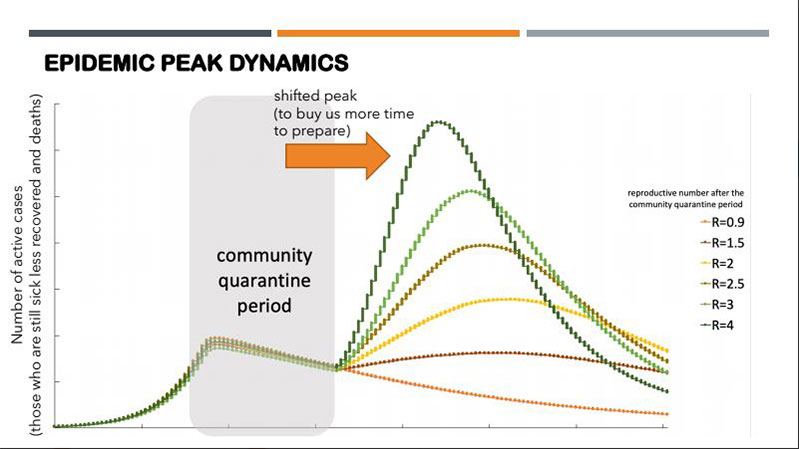

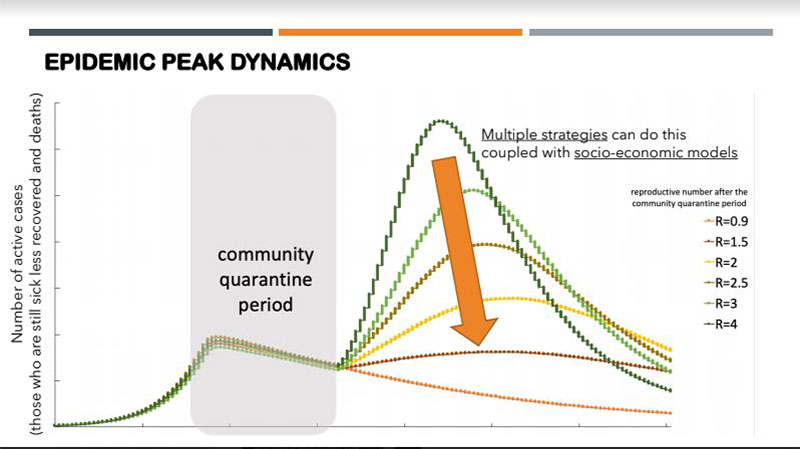
Multiple strategies suggested in war vs COVID-19
Given these circumstances, the UP pandemic team suggested multiple strategies, in addition to the ECQ, in response to the coronavirus outbreak.
These measures include maintaining social distancing and avoiding mass gatherings; inreasing detection and isolation, including mild and asymptomatic cases, to reduce infections; and increasing protection and good personal hygiene to reduce transmission.
UP scientists also proposed to increase clean and safe space and to implement physical distance between random people.
In hospitals, the report suggested to decrease the rate of patient encounter per health care worker, such as implementing a policy of maximum of three encounters per hour in a 12-hour work shift. Another proposal was to decrease the interaction time between the frontline health care worker and patients, with less than 40 minutes for the whole day.
The report also noted that providing protective gears and facilities to frontline health care workers during their shift is 95% effective.
Extending the community quarantine, in addition to multiple strategies mentioned above, are seen to further “shift the peak” of the epidemic to buy more time to prepare.
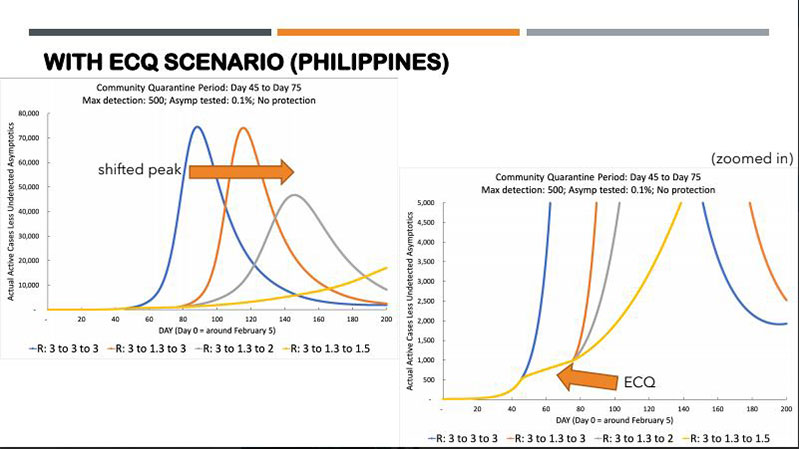
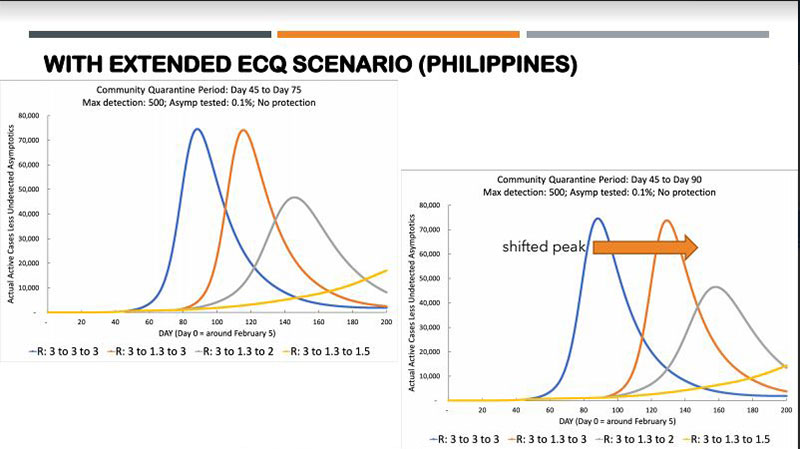
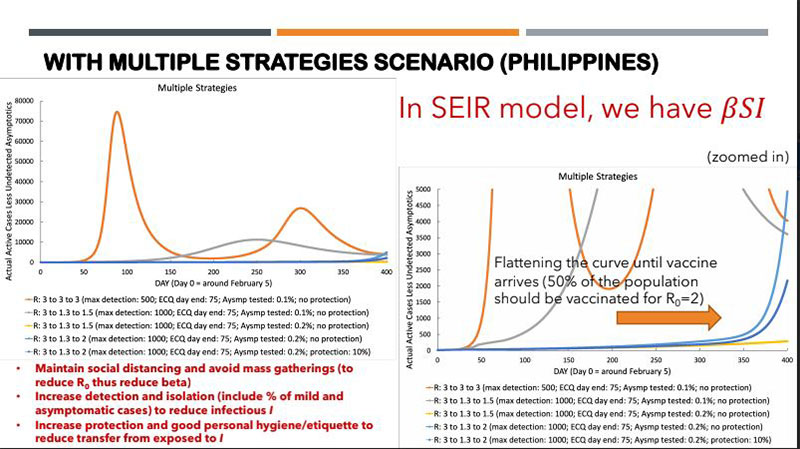
Philippines needs to prepare for long-term
Data scientist Jomar Rabajante, professor at UP Los Baños Institute of Mathematical Sciences and Physics, said the war against COVID-19 is not just in a month but may extend until vaccine arrives, which is expected next year.
Thus, the country needs to be prepared not just during the lockdown period but for the long-term.
“So we need more community collaboration to fight COVID. It is imperative to include multiple strategies not just ECQ, as we need to consider other factors such as socio-economic status of our country,” Rabajante told Philstar.com in an online exchange.
On the lifting of the ECQ, Rabajante said that if the government has solid strategies to move forward, the Philippines can do a modified community quarantine, which means that it would be local government unit-based and not national or Luzon-wide.
The UPLB professor also noted that before considering the lifting of the ECQ, LGUs must be equipped to implement protocols, such as regulated travel and quarantine of persons under monitoring and persons under investigation, to prevent initiation of outbreak.
The country should also have enough hospital beds, equipment, personnel and other healthcare support in case of a surge in the number of cases, he said.
“If the public is already prepared to change their ‘epidemic-friendly’ practices. That is, can we still maintain physical distancing in public (e.g. inside MRT)? Can we maintain or improve our personal hygiene habits? If not, then it is dangerous,” Rabajante told Philstar.com.
He also noted that the country’s hospitals should also have enough detection capability to identify those who are infected and isolate them immediately.
While the Philippines has yet to acquire vaccine and COVID-19 drugs, the country should at least have a strategy to control transmission to vulnerable people, such as the elderly and those who have weak immune system.
“If the government can guarantee enough provision of economic resources for vulnerable communities then ECQ can be extended, or else we need modified [community quarantine] where socio-economic factors are considered,” Rabajante said.
Mass testing to start April 14
On Thursday evening, Presidential Peace Adviser Carlito Galvez Jr., chief implementer of the national policy against COVID-19, announced that the government is planning to start mass testing of PUIs and PUMs starting April 14.
Earlier this week, the Food and Drug Administration (FDA) approved the use of five rapid test kits for the new coronavirus.
The FDA is also expected to issue a certificate of product registration to locally-made test kids on April 3. These test kits were developed by scientists from the University of the Philippines National Institutes of Health and the Philippine Genome Center, which will be manufactured by Manila HealthTek Inc.
“The Manila HealthTek Inc. reported that the first batch of reagents has arrived which will enable them to start the manufacturing process to create additional kits that can accommodate 120,000 tests,” the DOST earlier said.
(This was originally posted on the PhilStar website on April 3, 2020)
